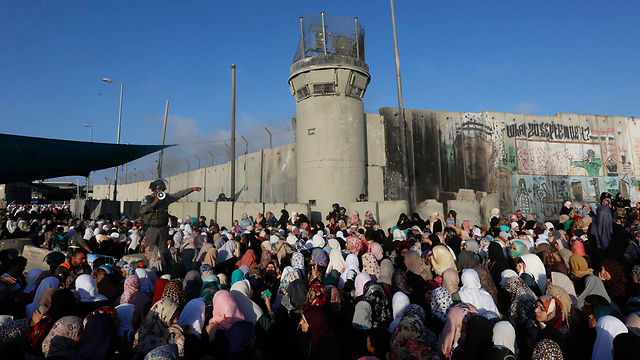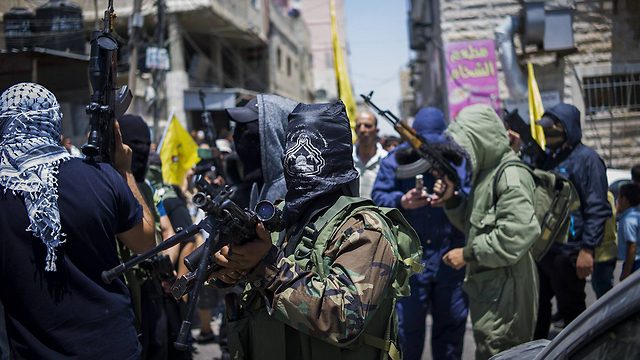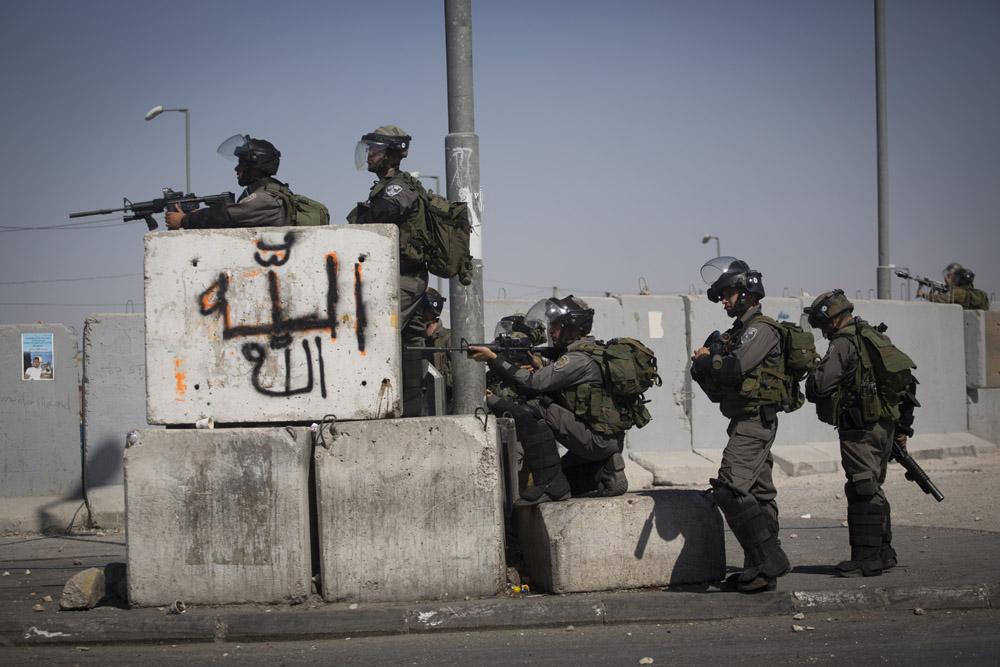Where angry young men are the only force

Members of the Al Aqsa brigades at Qalandiya refugee camp. Photo by Oren Ziv, Al Jazeera
Qalandiya refugee camp: A ‘chaotic base for terror’
The refugee camp on the outskirts of Jerusalem is a ‘no mans land’ in which terror and crime thrive and neither Israeli nor Palestinian security forces have control.
Elior Levy, Ynet news
July 16, 2015
The main reason for the current situation in the refugee camp is due to its location. Qalandiya is within Israel’s territorial jurisdiction but lies outside of the separation barrier, in the no-man’s land between Jerusalem and Ramallah. As a result, Israeli security forces rarely enter the camp, as every entry into the camp must be conducted as a small scale military operation. Palestinian security forces are legally barred from entering the camp but do occasionally attempt to show a certain presence within its boundaries.
Overview, Qalandiya refugee camp
As such, Qalandiya has become a comfortable base for both criminal enterprise and terrorist action against Israel. For example, the last Palestinian to be killed in a confrontation with security forces, Mohammed Al Ksbeh, lived in Qalandiya. Ksbeh had thrown a rock at the Binyamin Brigade commander’s jeep, smashing his windshield, and as a result was shot and killed. He was the third member of his family to be killed in confrontations with the IDF. Two of his brothers were killed in clashes with security forces during the second intifada.

A soldier directs the crowd at Qalandiya checkpoint. Photo by EPA.
Inside the camp there are armed groups made up of mostly unemployed youths. The majority of these groups’ members identify with the Fatah movement but are in no way tied to the policies of the Palestinian Authority, largely due to a sense of disenfranchisement among them.
The armed youths consider themselves part of the Al-Aqsa Martyrs Brigades, which was once the Fatah movement’s military wing. But the truth is Fatah’s military wing hasn’t really existed in an organized fashion in years. These youths along with their counterparts in the Jenin and Balata refugee camps, are just unorganized fragments of the same “Tanzim” organization that broke apart with the end of the second intifada.
The groups occasionally conduct marches to showcase their presence in the refugee camps, parading around while masked and armed.
They are also not afraid of shooting in the air, as they are well aware of the non-existent police infrastructure. In the past year, and more specifically during Operation Protective Edge, there were reports of armed gunmen firing from within protests near the Qalandiya checkpoint. Palestinian security forces attributed the gunfire to residents of the Qalandiya refugee camp.
In the early hours of August 26th 2013, an undercover unit of the Israeli border police entered the Qalandiya refugee camp. The Israeli army tried to arrest a wanted Palestinian man, but clashes erupted soon after, as the undercover force was discovered by the residents of the camp. During the clashes, three Palestinians were shot dead and 19 were injured, according to Palestinian medics.The funerals of Unis Jahjouh, 22, Rubeen Abed Fares, 30, and Jihad Aslan, 20, took place after the noon prayers in the refugee camp. Around 3000 people came to the funeral, which started in the houses of the deceased, then continued with a march to the local mosque. Text and photo by Oren Ziv
A Palestinian security official told Ynet that the Qalandiya refugee camp is “one big chaos.” According to the official, the Palestinian security apparatus occasionally conducts arrest operations in the camp but the actions are typically labeled as “kidnappings.” This is due to the fact that Palestinian security forces are not able to operate in the camp (as a result of the Oslo Accords.)

Armed men at Qalandiya checkpoint. Photo by Getty.
In order not to stir confrontation, the forces typically arrive dressed as civilians, and arrest suspects in a swift and quiet manner. The forces occasionally pluck people off the streets by pulling them into vehicles, and quickly heading off towards Ramallah.

Armed Palestinians militants take part in the funeral of Palestinian youth Mohammed Sami al-Ksabeh,/Mohammed Hani al-Kasbah 17, in Qalandiya refugee camp July 3, 2015. A senior Israeli army officer shot and killed Ksbeh who was throwing stones near a checkpoint in the West Bank on Friday, June 3, 2015. Photo by Yotam Ronen/Activestills.org
The official stated that these raids are necessary but are not enough to solve the serious security problem within the camp. Palestinian security sources estimate that a large number of weapons are present in the camp and its surrounding communities.
The armed groups provide security forces with quite a headache. The problem with Qalandiya in comparison to the other refugee camps is the fact that neither Israel nor Palestinian security services maintain a constant security presence.
Qalandiya camp and checkpoint (blue X) are in the mauve circle.

Notes and links
See also IDF killer’s false claim of self-defence
From UNWRA: Qalandiya refugee camp, established 1949, is formally under direct Israeli state control. It now has a population of 11,000 people, 60% of whom are under 25.
Its major problems are:
-
Unemployment
-
Insufficient sewage network
-
Destroyed roads
-
Bad camp conditions

